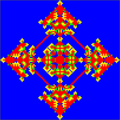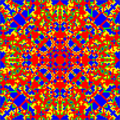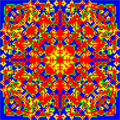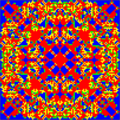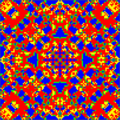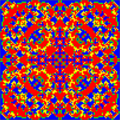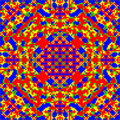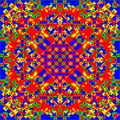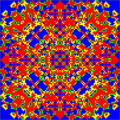Evolutionary Kaleidoscopes in the Snowdrift Game
For deterministic update rules (synchronous lattice update, best player in neighborhood reproduces) and symmetrical initial configurations this can lead to fascinating spatio-temporal patterns. Such evolutionary kaleidoscopes are certainly only of limited scientific interest but they do have quite some entertainment value.
- Evolutionary Kaleidoscopes in the Snowdrift Game (four neighbors)
-
-
-
-
-
-
-
-
-
-
-
-
-
-
-
-
-
-
-
-
EvoLudoLab
| Color code: | Cooperators | Defectors |
|---|---|---|
| New cooperator | New defector |
| Payoffs: | Low High
|
|---|
Note: The gradient of the payoff scale is augmented by pale shades of the strategy colours to mark payoffs that are achieved in homogeneous populations of the corresponding type.
Spatial Snowdrift or Hawk-Dove game: evolutionary kaleidoscopes
In spatially structured lattice populations with symmetrical initial configurations and deterministic updates fascinating spatio-temporal patterns emerge for suitable parameters and which resemble changing persian carpets or evolutionary kaleidoscopes. The initial symmetry is preserved by the determinsitic updates, i.e. synchronized lattice updates and only the individual with the highest payoff reproduces. Variation of the parameters leads to different types of kaleidoscopes. Here the cost-to-benefit ratio is set to , i.e. and and individuals interact with their four nearest neighbors on a square lattice with periodic boundary conditions.
Data views
| Snapshot of the spatial arrangement of strategies. | |
| Time evolution of the strategy frequencies. | |
| Snapshot of the spatial distribution of payoffs. | |
| Time evolution of average population payoff bounded by the minimum and maximum individual payoff. | |
| Snapshot of payoff distribution in population. | |
| Degree distribution in structured populations. | |
| Statistics of fixation probabilities. | |
| Statistics of fixation and absorption times. | |
| Statistics of the stationary distribution of the numbers of each strategic type. Note, only available for non-zero mutation rates. | |
| Message log from engine. |
Module parameters
The list below describes only the few parameters related to the Prisoner's Dilemma, Snowdrift and Hawk-Dove games. Follow the link for a complete list and detailed descriptions of the user interface and further parameters such as spatial arrangements or update rules on the player and population level.
- --paymatrix <a00,a01;a10,a11>
- 2x2 payoff matrix. Type \(A\) has index 0 and type \(B\) index 1.
- --inittype <type>
- type of initial configuration:
- frequency <f0>,<f1>...
- random distribution with given trait frequencies, f0, f1,.... Note, only available for frequency based modules and models.
- density <d0>,<d1>...
- initial trait densities <d1,...,dn>. Note, only available for density based modules and models.
- uniform
- uniform random distribution, equal frequencies of all traits.
- monomorphic <t>[,<v>]
- monomorphic initialization with trait t. Note, for modules with variable population densities, the optional parameter v indicates the initial frequency of vacant sites. If omitted the monomorphic trait is initialized at its (estimated) carrying capacity.
- mutant <m>,<r>[,<v>]
- single mutant with trait m in homogeneous resident population of type r. The mutant is placed in a location selected uniformly at random (mutants arising through cosmic rays). Note, for modules with variable population densities, the optional parameter v indicates the initial frequency of vacant sites. If omitted the resident trait is initialized at its (estimated) carrying capacity.
- temperature <m>,<r>[,<v>]
- single mutant with trait m in homogeneous resident population of type r. The mutant is placed in a location selected proportional to the in-degree of nodes (temperature initialization, mutants arising through errors in reproduction). Note, for modules with variable population densities, the optional parameter v indicates the initial frequency of vacant sites. If omitted the resident trait is initialized at its (estimated) carrying capacity.
- stripes
- stripes of traits. Note, only available for 2D lattices.
- kaleidoscopes
- configurations that produce evolutionary kaleidoscopes for deterministic updates (players and population). Note, only available for some modules.
Note, for modules that admit multiple species, the initialization types for each species can be specified as an array separated by ;. With more species than initialization types, they are assigned in a cyclical manner.


